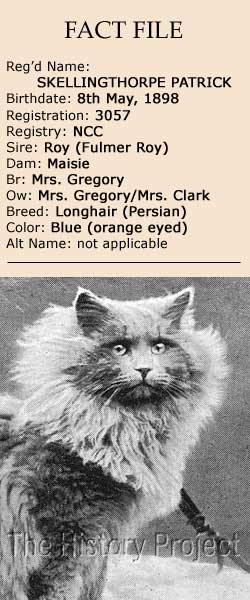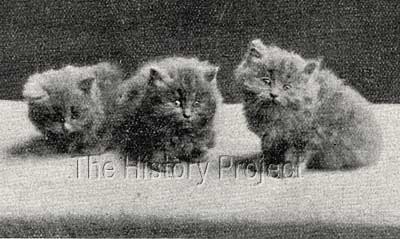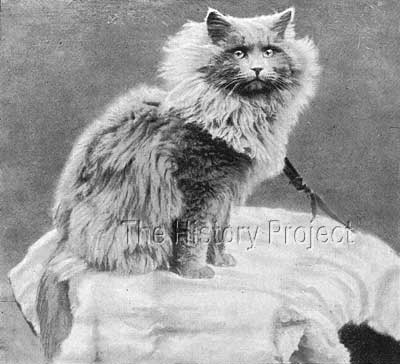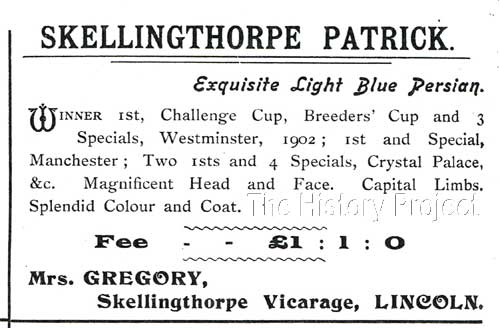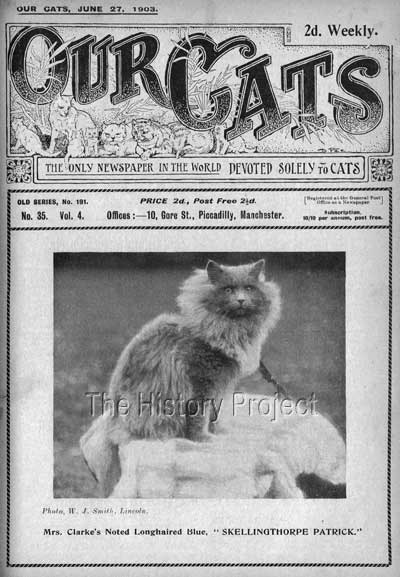 | ||||||||||||||||









|
SKELLINGTHORPE PATRICK (1898)PHOTOS | SOCIAL MEDIA | REFERENCES
HISTORICAL BACKGROUND:Between late 1898 and 1902, 'Skellingthorpe Patrick' set a benchmark for Blue Persians, for size, head style and paleness of coat. His stud advertisement from the period calls to our attention these assets, which are summarily describes him as an "exquisitely light blue Persian" and then adds, "Magnificent head and face. Capital Limbs. Splendid Colour and Coat." Certainly, from the photo provided by W.J. Smith of Lincoln, we can see these attributes in full measure and can therefore appreciate that in his day, he was really quite something to behold. During this time, the development of the Blue Persian was all about refinements, getting better coat colour consistency, obtaining a fuller, longer coat, with the highly desired ear and toe tuft furnishings, possessing great bone and musculature of frame, lowering the ear set and improving eye colour, while maintaining a fuller, rounder face of handsome countenance. In the second printing of Frances Simpson's book Our Cats and All About Them (1902) which was renamed Cats for Pleasure and Profit(1909), she adds a brief description of 'Skellingthorpe Patrick' as the first of only four blues illustrated in this volume. It simply reads:- "SKELLINGTHORPE PATRICK was bred by Mrs Gregory, and after winning, several prizes at our best shows was purchased by Mrs Clark, of Batheaston, and is placed at stud. This fine blue is pale in colour, and carries a grand coat. He has sired some good kittens....." 2 We may forgive Frances a tad of favourtism in selecting 'Patrick' in these listings for which there would have been a wide selection of males to choose from. Although it is seldom if ever mentioned, his maternal grandsire was 'Persimmon', the beloved Brown Tabby, owned and passionately promoted by Frances Simpson. However on balance we can forgive her this slight transgression as she shows her sound judgment with the following comment when speaking about colour breeding in relation to eye colour:- "Of the crossing of blues with any other colour I do not approve, because we have many different blue strains, among which can be found all the different points which are desired. Comparisons are odious, but if I refer to the Bath Show of 1903 I can explain what I mean. 'Skellingthorpe Patrick' is a beautiful cat in all points except eyes, but 'Don Carlos' and several other blue males in the class, had glorious orange eyes."1 So in this comment, we are given an insight into perhaps 'Patrick's' one possible weakness, his need for stronger eye colour. PARENTAGE & OWNERSHIP:'Skellingthorpe Patrick' was born on 8th May, 1898, bred by Mrs Gregory, sired by 'Roy' (later 'Fulmer Roy), a worthy grandson of two early pillars of blue Persian breeding, 'Ch. Bundle' via his own sire, and the ever popular 'Ch. Wooloomooloo' through his own dam. 'Patrick's' dam, 'Maisie' was another blue, but with a little secret, while her own dam 'Bluebelle' was also a Blue, her sire, was the heavily boned and heavily coated 'Ch. Persimmon' (1897), the celebrated Brown Tabby male owned by Frances Simpson.
Kingfisher, Blue
Fulmer Roy, Blue
| Ethel, Blue
Skellingthorpe Patrick, May-08-1898, Blue, M
| Ch Persimmon, Brown Tabby
Maisie, Blue
Bluebelle, Blue
From a judging perspective however, it did not matter what colour or pattern your parent or grandparent may have been, what truly mattered was whether you had the type or conformation, coupled with the coat and furnishings, the boning, and the evenness of colour expected in a blue Persian male. And in his case, 'Skellingthorpe Patrick' had all these qualities in spades, and in the case of colour, he was what would have been referred to as a 'pastel' blue. In addition to these obvious advantages, he was extremely pleasant of countenance, having an open alert expression. His secured notoriety with classic wins in the Blue Persian classes at the Crystal Palace for two years running, followed by other classic wins as he matured, this strikingly handsome male remained the property of his breeder Mrs Gregory for the first five years of his life. But around April/May of 1903, 'Patrick' changed hands, moving from Mrs Gregory to Mrs Clark, of 'Ashbrittle' cattery fame. This transfer was announced in the columns of Our Cats in the 2nd May issue, 1903 as follows: - "Mrs E. A. Clarke has bought from Mrs Gregory the noted Blue Persian, Skellingthorpe Patrick, for a high price. This beautiful cat is too well known to need any commendation from us, and we content ourselves with hoping that good fortune will continue to follow him. Mrs Clarke is advertising her new acquisition at stud in our columns, and also her short-hair blue, winner of two firsts and a special at Bath."3 The short-haired blue mentioned along with 'Patrick' is most likely to have been Mrs Clarkes equally well-known 'Ashbrittle Peter The Great'. A copy of the advertisement mentioned in this report is included in the Social Media section further down on this page. SIBLINGS & SHOWS:Official records show only one full sibling for 'Skellingthorpe Patrick' born in the same litter, a blue Persian female named 'Daphne' which became the property of Mrs W. M. Hunt, a well-established breeder and fancier of Blues since the early 1890's. Of his show wins, we have those listed with his registration, which include his exemplary wins at the Crystal Palace, in the Blue Persian classes, being a first in 1898; and 1st again at the Crystal Palace, in 1899. These were the sorts of wins that propelled cats into the sphere of fame and recognition, and this cat was no exception. But he enhanced these early wins with more success, including First, Challenge Cup, Breeders Cup and three Specials at Westminster in 1902; First and Special at Manchester; followed by two Firsts and four Specials once again, at the Crystal Palace. By the end of 1902, his fame and popularity were immense and he needed no recommendation. All of these achievements he gained while still the property of his breeder, Mrs. Gregory. BREEDING & PROGENY:Although he remained a popular stud, very few of his progeny ever gained the same sort of notoriety that had followed their well-known sire.
A blue female, named 'Blue Mischief' is recorded as born in February 1900, out of an unknown female, herself sired by 'Ch. Wooloomooloo'. This in itself was a well planned and executed breeding as it doubled directly on that famous sire, who was already the great-grandsire of 'Patrick'. However, a blue male, who is registered as 'Lord Christopher of Glenfoyle', in the first volume of the Register of American Cat Association, born 23rd April 1902 out of the dam simply known as 'Blue Jeanie', appears to have been bred by Mrs. Fawfsett of Lincolnshire and successfully exported to a Mrs. Andrew Chrystal of Marshall, Michigan.8 Similarly, a Black male, registered as 'Columbia Patrick', similarly appears both in Volume I of the Cat Fanciers' Association Stud-book (355)10 and that of the Beresford Cat Club (856)9, born 8th July, 1902, sired by 'Patrick' and out of a Smoke female (probably a Black Smoke) named 'Namoushka' (a descendant of 'Ch .Blue Boy the Great'). His breeder is recorded as Mrs. Holmes, and he appears to have been initially exported to a Mrs. Condor, and then moved on to an Eleanor L. Burritt, of Washington D.C. This cat is also credited with gaining a 'Highly Commended' at a Show in New York, in 1904. PHOTOS:
SOCIAL MEDIA :
REFERENCES:
Registers associated with this article include The Incorporated Cat Fanciers Association of Great Britain (TICFAGB), National Cat Club (NCC), The Cat Club (CCR), Beresford Cat Club (BCC), Feline Federation Francaise (FFF), Siamese Cat Registry (SCR), US Register & Studbook for Cats (USR)including Supplement(USRS), The Studbook of the American Cat Association (ACA), and the Studbook & Register of the Cat Fanciers' Association (CFA).
|
|||||||||||||||
Home | Cats | Gallery | Clubs | People | Artifacts | Articles | Updates | Contact Us ©The CFA Foundation, Inc and The Harrison Weir Collection
|
||||||||||||||||
